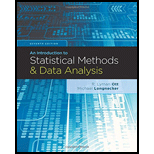
An Introduction to Statistical Methods and Data Analysis
7th Edition
ISBN: 9781305269477
Author: R. Lyman Ott, Micheal T. Longnecker
Publisher: Cengage Learning
expand_more
expand_more
format_list_bulleted
Concept explainers
Expert Solution & Answer
Want to see the full answer?
Check out a sample textbook solution
Students have asked these similar questions
A cable TV company was interested in making its operation more efficient by cutting down on the distance between service calls while still maintaining at least the same level of service quality. A treatment group of 18 repairpersons was assigned to a dispatcher who monitored all the incoming requests for cable repairs and then provided a service strategy for that day’s work orders. A control group of 18 repairpersons was to perform their work in a normal fashion—that is, by providing service in roughly a sequential order as requests for repairs were received. The average daily mileages for the 36 repairpersons are recorded in the table below.
What are the populations of interest in this study?
What is the level of significance of your test?
Is there significant evidence that the treatment group had a smaller average daily mileage than the control group? Use α = 0.05.
The queuing systems inside of McDonald's and Taco Bell/Wendy's were the subject of analysis. Considering how we could mathematically evaluate the efficiency of each system: two lines each, with their own server or a single queue that leads to two servers. considering the psychology around the wait, and how that might affect balking and negative behavior, or promote increased purchases by forcing customers to view promotions or menus for longer times.
The question is whether the same aspects - mathematically and psychologically - apply to drive through settings. Do the same mechanics apply? How so or how not?
The manager of the customer service department at a bank can hire employees with a high school degree (HS) who earn $10,000 annually or employees with a bachelor's degree (B) who earn $20,000. The manager wants to maximize the number of customers served given a fixed payroll.
Worker Number of Additional Customers Served
High School Degree Bachelor's Degree
1st 80 90
2nd 60 80
3rd 50 60
4th 40 40
5th 35 35
6th 30 25
Given the information in the table, if the manager's payroll is $120,000, what should be done to maximize the number of customers served?
What is the math behind this? Do I just look back and select which degrees equal 0.5? That would take a lot of manual work to do that. Is their an easier way?
Chapter 6 Solutions
An Introduction to Statistical Methods and Data Analysis
Ch. 6.9 - Refer to the oil-spill case study.
What are the...Ch. 6.9 - For each of the situations, set up the rejection...Ch. 6.9 - Conduct a test of H0 : μ1 μ2 – 2.3 versus Ha : μ1...Ch. 6.9 - In an effort to link cold environments with...Ch. 6.9 - The Department of Natural Resources (DNR) received...Ch. 6.9 - An industrial engineer conjectures that a major...Ch. 6.9 - The number of households currently receiving a...Ch. 6.9 - Prob. 9ECh. 6.9 - Refer to Exercise 6.11. There appears to be a...Ch. 6.9 - A firm has a generous but rather complicated...
Ch. 6.9 - Prob. 14ECh. 6.9 - Random samples of size n1 = 8 and n2 = 8 were...Ch. 6.9 - Prob. 16ECh. 6.9 - Prob. 17ECh. 6.9 - The paper Serum Beta-2-Microglobulin (SB2M) in...Ch. 6.9 - Prob. 19ECh. 6.9 - Prob. 20ECh. 6.9 - Prob. 21ECh. 6.9 - Prob. 22ECh. 6.9 - A random sample of eight pairs of twins was...Ch. 6.9 - Refer to the data of Exercise 6.11. A potential...Ch. 6.9 - Researchers are studying two existing coatings...Ch. 6.9 - Prob. 27ECh. 6.9 - The paper “Effect of Long-Term Blood Pressure...Ch. 6.9 - A study was designed to measure the effect of home...Ch. 6.9 - Prob. 30ECh. 6.9 - A random sample of eight pairs of twins were...Ch. 6.9 - Refer to Exercise 6.31. a. What is the level of...Ch. 6.9 - Use the level and power values for the paired t...Ch. 6.9 - Use the level and power values for the paired t...Ch. 6.9 - A study was conducted to determine whether...Ch. 6.9 - The effect of Benzedrine on the heart rate of dogs...Ch. 6.9 - Prob. 37E
Knowledge Booster
Learn more about
Need a deep-dive on the concept behind this application? Look no further. Learn more about this topic, statistics and related others by exploring similar questions and additional content below.Recommended textbooks for you
 Linear Algebra: A Modern IntroductionAlgebraISBN:9781285463247Author:David PoolePublisher:Cengage Learning
Linear Algebra: A Modern IntroductionAlgebraISBN:9781285463247Author:David PoolePublisher:Cengage Learning

Linear Algebra: A Modern Introduction
Algebra
ISBN:9781285463247
Author:David Poole
Publisher:Cengage Learning
Statistics 4.1 Point Estimators; Author: Dr. Jack L. Jackson II;https://www.youtube.com/watch?v=2MrI0J8XCEE;License: Standard YouTube License, CC-BY
Statistics 101: Point Estimators; Author: Brandon Foltz;https://www.youtube.com/watch?v=4v41z3HwLaM;License: Standard YouTube License, CC-BY
Central limit theorem; Author: 365 Data Science;https://www.youtube.com/watch?v=b5xQmk9veZ4;License: Standard YouTube License, CC-BY
Point Estimate Definition & Example; Author: Prof. Essa;https://www.youtube.com/watch?v=OTVwtvQmSn0;License: Standard Youtube License
Point Estimation; Author: Vamsidhar Ambatipudi;https://www.youtube.com/watch?v=flqhlM2bZWc;License: Standard Youtube License